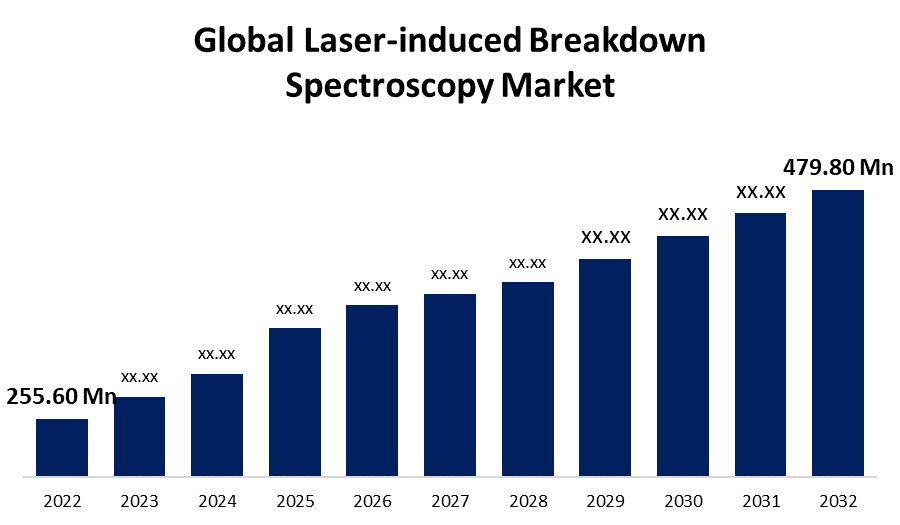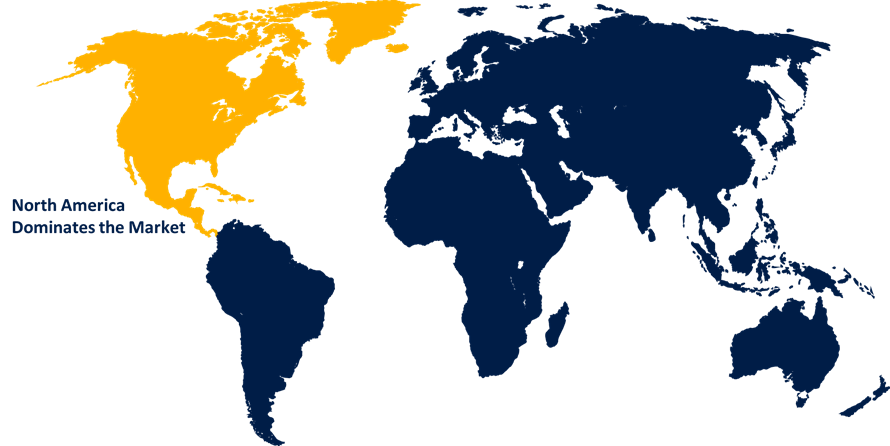Global Laser-induced Breakdown Spectroscopy Market Size, Share, and COVID-19 Impact Analysis, By Product (Handheld and Desktop), By End-User (Academic & Research Institutes, Pharmaceuticals & Biotechnology Companies, and Others), By Region (North America, Europe, Asia-Pacific, Latin America, Middle East, and Africa), Analysis and Forecast 2022 – 2032).
Industry: HealthcareGlobal Laser-induced Breakdown Spectroscopy Market Insights Forecasts to 2032
- The Laser-induced breakdown spectroscopy market was valued at USD 255.60 Million in 2022.
- The Market is growing at a CAGR of 6.5% from 2023 to 2032.
- The Global Laser-induced breakdown spectroscopy market is expected to reach USD 479.80 Million by 2032.
- Asia-Pacific is expected to grow fastest during the forecast period.

Get more details on this report -
The Global Laser-induced breakdown spectroscopy market is expected to reach USD 479.80 Million by 2032, at a CAGR of 6.5% during the forecast period 2023 to 2032.
Market Overview
Laser-induced Breakdown Spectroscopy (LIBS) is an analytical technique that utilizes intense laser pulses to generate plasma from a sample, allowing for elemental analysis. By focusing a laser beam on the sample surface, the high-energy photons create a plasma plume, leading to the emission of characteristic atomic and molecular spectra. LIBS offers several advantages, including minimal sample preparation, non-destructive analysis, and rapid data acquisition. The emitted spectra contain information about the elemental composition of the sample, enabling qualitative and quantitative analysis. LIBS finds applications in various fields, including environmental monitoring, material science, archaeology, and forensic analysis. Ongoing advancements in laser technology and data processing techniques continue to enhance the sensitivity, accuracy, and versatility of LIBS, making it a valuable tool for scientific research and industrial applications.
Report Coverage
This research report categorizes the market for laser-induced breakdown spectroscopy market based on various segments and regions and forecasts revenue growth and analyzes trends in each submarket. The report analyses the key growth drivers, opportunities, and challenges influencing the laser-induced breakdown spectroscopy market. Recent market developments and competitive strategies such as expansion, product launch, and development, partnership, merger, and acquisition have been included to draw the competitive landscape in the market. The report strategically identifies and profiles the key market players and analyses their core competencies in each sub-segments of the laser-induced breakdown spectroscopy market.
Global Laser-induced Breakdown Spectroscopy Market Report Coverage
| Report Coverage | Details |
|---|---|
| Base Year: | 2022 |
| Market Size in 2022: | USD 255.60 Mn |
| Forecast Period: | 2022 – 2032 |
| Forecast Period CAGR 2022 – 2032 : | 6.5% |
| 022 – 2032 Value Projection: | USD 479.80 Mn |
| Historical Data for: | 2018-2021 |
| No. of Pages: | 200 |
| Tables, Charts & Figures: | 140 |
| Segments covered: | By Product, By End-User, By Region. |
| Companies covered:: | Thermo Fisher Scientific Inc., Hitachi High-Tech Analytical Science, SciAps, Inc., Rigaku, Bruker Corporation, TSI Incorporated, Princeton Instruments, Avantes, B&W Tek, Applied Spectra, SECOPTA analytics GmbH, and Others. |
| Pitfalls & Challenges: | COVID-19 Empact, Challenge, Future, Growth, & Analysis |
Get more details on this report -
Driving Factors
Laser-induced Breakdown Spectroscopy (LIBS) market is driven by several factors, such as the increasing demand for fast and accurate elemental analysis across various industries, including environmental monitoring, pharmaceuticals, and metals and mining, is fueling the growth of the LIBS market. LIBS offers real-time, non-destructive analysis with minimal sample preparation, making it an attractive choice for quality control and process monitoring applications. Additionally, technological advancements in laser sources, detector systems, and data analysis software are enhancing the performance and capabilities of LIBS systems, further driving the market growth. Moreover, the rising focus on sustainable practices and stringent regulations related to environmental monitoring and safety is creating a demand for efficient and reliable analytical techniques like LIBS. The expanding applications of LIBS in fields such as archaeology, forensics, and aerospace also contribute to the market's growth potential.
Restraining Factors
Despite its numerous advantages, the Laser-induced Breakdown Spectroscopy (LIBS) market faces certain restraints. One major limitation is the high initial cost of LIBS systems, which can be a deterrent for smaller businesses or research facilities with limited budgets. Additionally, the complexity of data interpretation and analysis in LIBS can pose challenges for users, requiring specialized expertise and training. The technique is also limited by its sensitivity to surface conditions, such as roughness and contamination, which can affect measurement accuracy. Furthermore, the availability of alternative spectroscopic techniques and competing technologies, such as X-ray fluorescence spectroscopy and inductively coupled plasma spectroscopy, may impact the adoption of LIBS in certain applications.
Market Segmentation
- In 2022, the handheld segment accounted for around 60.2% market share
On the basis of the product, the global laser-induced breakdown spectroscopy market is segmented into handheld and desktop. The handheld segment held the largest market share in the laser-induced breakdown spectroscopy (LIBS) market. There are several reasons behind this dominance, such as handheld LIBS devices offer portability and ease of use, allowing users to perform on-site analysis without the need for sample transportation to a laboratory. This feature is particularly advantageous in industries such as mining, environmental monitoring, and field research where real-time analysis is required. Handheld LIBS devices also eliminate the need for extensive sample preparation, saving time and resources. Additionally, advancements in miniaturization and battery technologies have made handheld LIBS devices more compact and lightweight, further enhancing their convenience and practicality. These devices provide rapid results, enabling quick decision-making and efficient data acquisition. Furthermore, the handheld LIBS market has witnessed significant technological advancements in recent years, leading to improved performance, sensitivity, and accuracy. Manufacturers have focused on developing rugged and robust handheld devices capable of withstanding harsh environments and providing reliable analysis. The cost-effectiveness of handheld LIBS devices is another factor contributing to their market dominance. They offer a more affordable option compared to larger, benchtop LIBS systems, making them accessible to a broader range of industries and applications. Overall, the combination of portability, ease of use, rapid analysis, technological advancements, and cost-effectiveness has propelled the handheld segment to hold the largest market share in the LIBS market.
- In 2022, the pharmaceuticals & biotechnology companies segment dominated with more than 41.5% market share
Based on the end-user, the global laser-induced breakdown spectroscopy market is segmented into academic & research institutes, pharmaceuticals & biotechnology companies, and others. The pharmaceuticals and biotechnology companies segment has dominated the Laser-induced Breakdown Spectroscopy (LIBS) market. Many reasons contribute to this dominance because the pharmaceutical industry relies heavily on accurate elemental analysis for quality control, drug development, and regulatory compliance. LIBS offers a rapid and non-destructive technique for analyzing raw materials, active pharmaceutical ingredients (APIs), and finished products, ensuring their composition meets stringent standards. LIBS also enables in-line process monitoring, enhancing manufacturing efficiency and reducing downtime. Furthermore, the biotechnology sector utilizes LIBS for elemental analysis of biological samples, such as tissues, cells, and biofluids, aiding in research, drug discovery, and biomarker identification. LIBS provides a valuable tool for analyzing trace elements and studying the elemental composition of biological samples, contributing to advancements in biotechnology and personalized medicine. Additionally, the pharmaceuticals and biotechnology industries have significant research and development budgets, allowing them to invest in advanced analytical techniques like LIBS. These sectors are at the forefront of technological advancements and are constantly seeking innovative solutions to enhance their processes and products. LIBS, with its capabilities for multi-elemental analysis and non-destructive sampling, aligns well with their requirements. Moreover, stringent regulations and quality control standards imposed on pharmaceuticals and biotechnology products necessitate accurate elemental analysis throughout the production and research processes. LIBS offers a reliable and efficient solution to meet these regulatory requirements, ensuring product safety and efficacy. Overall, the dominance of the pharmaceuticals and biotechnology companies segment in the LIBS market can be attributed to the industry's need for precise elemental analysis, regulatory compliance, research and development focus, and the ability to invest in advanced analytical techniques.
Regional Segment Analysis of the Laser-induced Breakdown Spectroscopy Market
- North America (U.S., Canada, Mexico)
- Europe (Germany, France, U.K., Italy, Spain, Rest of Europe)
- Asia-Pacific (China, Japan, India, Rest of APAC)
- South America (Brazil and the Rest of South America)
- The Middle East and Africa (UAE, South Africa, Rest of MEA)
North America dominated the market with more than 43.8% revenue share in 2022.

Get more details on this report -
Based on region, North America holds a dominant position in the Laser-induced Breakdown Spectroscopy (LIBS) market. North America has a strong presence of key market players and research institutions actively engaged in the development and commercialization of LIBS technology. This facilitates the availability of advanced LIBS systems and related services in the region. Additionally, North America has a well-established industrial sector, including aerospace, automotive, and pharmaceutical industries, which have a high demand for elemental analysis techniques like LIBS. The region also benefits from stringent regulations and quality control standards, driving the adoption of reliable and accurate analytical methods such as LIBS. Moreover, significant investments in research and development activities, coupled with collaborations between academia and industry, further promote the growth of the LIBS market in North America.
Recent Developments
- In May 2023, Thermo Fisher Scientific introduced a new function for the Thermo Scientific Niton Apollo portable laser-induced breakdown spectroscopy analyzer. Customers in diverse contexts, such as oil refineries and stainless-steel production facilities, may now analyse tiny components using this compact and user-friendly equipment, which employs optical emission spectroscopy.
- In November 2022, Rigaku Analytical Devices sold Ocean Insight Handheld Aluminium Analyzers and SpeedSorter. Ocean Insight provides clients with increased flexibility for analysing aluminium in a variety of conditions and alloy grades by using innovative high-speed aluminium sorting technology. This allows consumers to more effectively determine the chemical makeup of individual pieces of waste aluminium, allowing for better sorting into separate categories that can be economically melted down and recycled.
Competitive Analysis:
The report offers the appropriate analysis of the key organizations/companies involved within the global laser-induced breakdown spectroscopy market along with a comparative evaluation primarily based on their product offering, business overviews, geographic presence, enterprise strategies, segment market share, and SWOT analysis. The report also provides an elaborative analysis focusing on the current news and developments of the companies, which includes product development, innovations, joint ventures, partnerships, mergers & acquisitions, strategic alliances, and others. This allows for the evaluation of the overall competition within the market.
List of Companies:
- Thermo Fisher Scientific Inc.
- Hitachi High-Tech Analytical Science
- SciAps, Inc.
- Rigaku, Bruker Corporation
- TSI Incorporated
- Princeton Instruments
- Avantes
- B&W Tek
- Applied Spectra
- SECOPTA analytics GmbH
Key Target Audience
- Market Players
- Investors
- End-Users
- Government Authorities
- Consulting and Research Firm
- Venture Capitalists
- Value-Added Resellers (VARs)
Market Segment
This study forecasts revenue at global, regional, and country levels from 2019 to 2032. Spherical Insights has segmented the global laser-induced breakdown spectroscopy market based on the below-mentioned segments:
Laser-induced Breakdown Spectroscopy Market, By Product
- Handheld
- Desktop
Laser-induced Breakdown Spectroscopy Market, By End-User
- Academic & Research Institutes
- Pharmaceuticals & Biotechnology Companies
- Others
Laser-induced Breakdown Spectroscopy Market, Regional Analysis
- North America
- US
- Canada
- Mexico
- Europe
- Germany
- UK
- France
- Italy
- Spain
- Russia
- Rest of Europe
- Asia Pacific
- China
- Japan
- India
- South Korea
- Australia
- Rest of Asia Pacific
- South America
- Brazil
- Argentina
- Rest of South America
- Middle East & Africa
- UAE
- Saudi Arabia
- Qatar
- South Africa
- Rest of Middle East & Africa
Need help to buy this report?